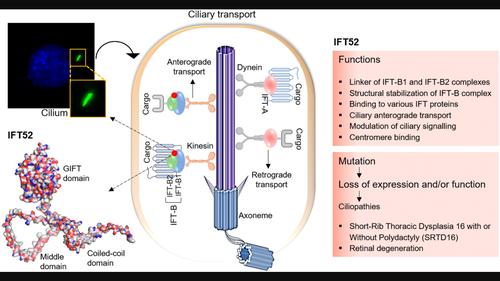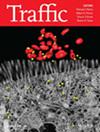纤毛运输和纤毛疾病中纤毛内运输 52 的新功能
IF 2.5
3区 生物学
Q3 CELL BIOLOGY
引用次数: 0
摘要
真核细胞中的纤毛转运是一个复杂而保守的过程,涉及多蛋白鞘内转运(IFT)复合体的协调组装和运作。在各种 IFT 蛋白中,鞘内转运 52(IFT52)在纤毛转运中起着至关重要的作用,并与各种纤毛疾病有关。IFT52 是 IFT-B 复合物的核心成分,可促进货物沿纤毛轴丝移动。IFT-B 复合物中的 IFT52 与 IFT-B1 和 IFT-B2 亚复合物的稳定结合调节着纤毛成分的循环以及信号转导和分子运动等纤毛功能的维持。IFT52 基因突变会破坏纤毛的运输,导致纤毛功能障碍,影响纤毛疾病的细胞过程。由 IFT52 基因突变引起的纤毛疾病具有多种临床特征,包括骨骼发育异常、视网膜变性、呼吸衰竭和神经系统异常。因此,IFT52 是诊断各种纤毛症(包括伴有或不伴有多指畸形的短肋胸廓发育不良 16)的一种很有前景的生物标记物。在此,我们概述了 IFT52 介导的纤毛运输分子机制,并描述了导致与纤毛功能障碍相关的不同疾病的 IFT52 基因突变。本文章由计算机程序翻译,如有差异,请以英文原文为准。

The emerging functions of intraflagellar transport 52 in ciliary transport and ciliopathies
Ciliary transport in eukaryotic cells is an intricate and conserved process involving the coordinated assembly and functioning of a multiprotein intraflagellar transport (IFT) complex. Among the various IFT proteins, intraflagellar transport 52 (IFT52) plays a crucial role in ciliary transport and is implicated in various ciliopathies. IFT52 is a core component of the IFT-B complex that facilitates movement of cargoes along the ciliary axoneme. Stable binding of the IFT-B1 and IFT-B2 subcomplexes by IFT52 in the IFT-B complex regulates recycling of ciliary components and maintenance of ciliary functions such as signal transduction and molecular movement. Mutations in the IFT52 gene can disrupt ciliary trafficking, resulting in dysfunctional cilia and affecting cellular processes in ciliopathies. Such ciliopathies caused by IFT52 mutations exhibit a wide range of clinical features, including skeletal developmental abnormalities, retinal degeneration, respiratory failure and neurological abnormalities in affected individuals. Therefore, IFT52 serves as a promising biomarker for the diagnosis of various ciliopathies, including short-rib thoracic dysplasia 16 with or without polydactyly. Here, we provide an overview of the IFT52-mediated molecular mechanisms underlying ciliary transport and describe the IFT52 mutations that cause different disorders associated with cilia dysfunction.
求助全文
通过发布文献求助,成功后即可免费获取论文全文。
去求助
来源期刊

Traffic
生物-细胞生物学
CiteScore
8.10
自引率
2.20%
发文量
50
审稿时长
2 months
期刊介绍:
Traffic encourages and facilitates the publication of papers in any field relating to intracellular transport in health and disease. Traffic papers span disciplines such as developmental biology, neuroscience, innate and adaptive immunity, epithelial cell biology, intracellular pathogens and host-pathogen interactions, among others using any eukaryotic model system. Areas of particular interest include protein, nucleic acid and lipid traffic, molecular motors, intracellular pathogens, intracellular proteolysis, nuclear import and export, cytokinesis and the cell cycle, the interface between signaling and trafficking or localization, protein translocation, the cell biology of adaptive an innate immunity, organelle biogenesis, metabolism, cell polarity and organization, and organelle movement.
All aspects of the structural, molecular biology, biochemistry, genetics, morphology, intracellular signaling and relationship to hereditary or infectious diseases will be covered. Manuscripts must provide a clear conceptual or mechanistic advance. The editors will reject papers that require major changes, including addition of significant experimental data or other significant revision.
Traffic will consider manuscripts of any length, but encourages authors to limit their papers to 16 typeset pages or less.
 求助内容:
求助内容: 应助结果提醒方式:
应助结果提醒方式:


